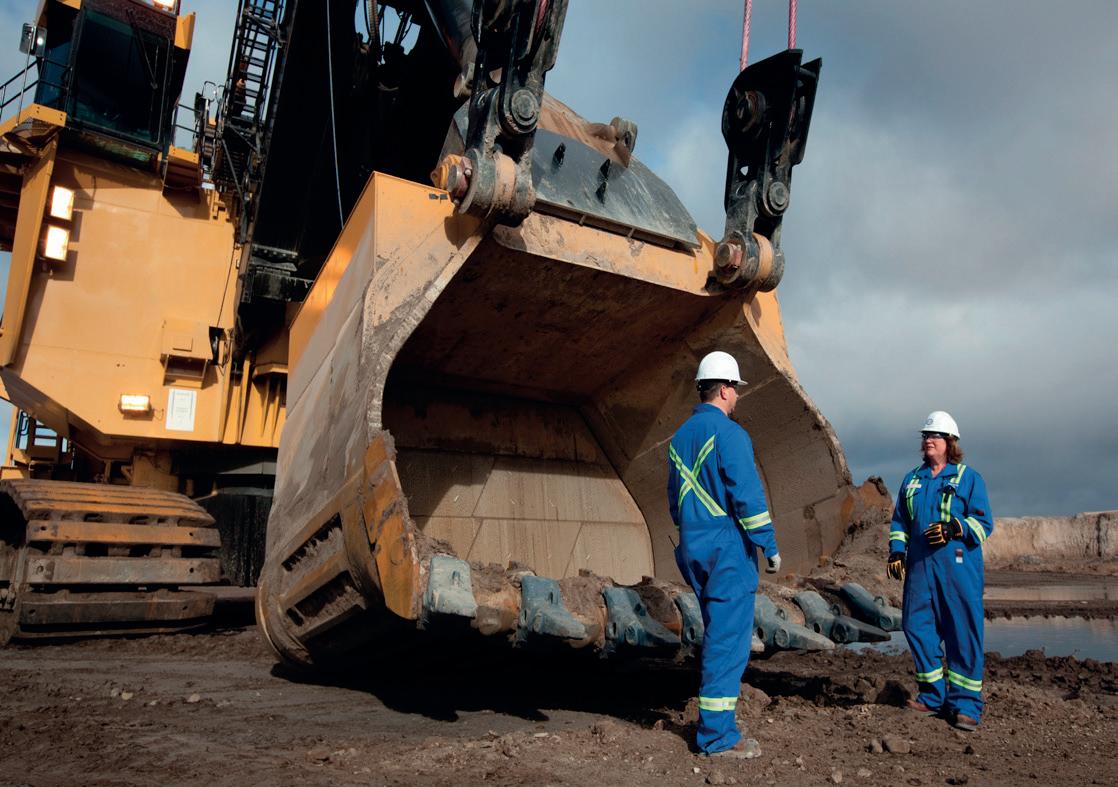
5 minute read
Protecting Open Gears In Shovels
Roger Young, Imperial Oil, Canada,
provides an overview of the keys to preventing unwanted shovel downtime through the proper lubrication of open gear components.
Figure 1. Shovel in production loading a 400 t haul truck at Kearl Mine, Canada 2017. A t the centre of every mine site, shovels, and the proper maintenance of them, can be vital when preventing any unplanned downtime. They can not only directly contribute to a mines’ productivity, but they can be some of the most important pieces of equipment on site. Creating a proper lubrication program can help optimise shovel availability and can significantly improve mining efficiency. While these optimisation efforts are often difficult to execute effectively, there are multiple strategies to assist in maximising shovel uptime.
Inefficient shovel cycles, difficult material identification, unclear progress line definitions, and extensive manual monitoring are some of the challenges shovel operators face on a regular basis. Understanding what the common causes for shovel downtime are before they occur is important to preventing problems and optimising shovel uptime. Specifically, moving from a reactive maintenance strategy to a predictive one can help improve fleet uptime.

Protection challenges
Open gears in critical mining equipment — such as shovels, draglines, and drils — can be especially challenging to protect, due to their exposure to extreme temperatures, rain, snow, and contaminants – such as dust, dirt, and other corrosive materials. Open gear equipment can also commonly operate in extreme conditions – such as heavy loads, low speeds, and reversing directions. This can lead to wear and even premature failure. Protecting your open gear equipment despite these challenges demands a multifaceted approach, which includes: n Choosing the right lubricants. n Applying lubricants properly and monitoring lubricant performance. n Managing the centralised grease system properly. n Working with a supplier who can provide lubrication expertise.
Choose the right lubricants
Optimum protection for open gears requires using high-quality lubricants, preferably ones that are specifically formulated for the applications. Lubricant quality can vary widely, and you should choose a lubricant formulated to handle the typical challenges open gears face. When making your lubricant selection, consider the following challenges, formulations, and lubricant capabilities.
Severe loads and extreme pressures will greatly impact the correct lubricant choice. For open gear lubricants, consider choosing the heaviest viscosity product for your ambient tempreture, while ensuring that it can work with your central lubrication system. To help minimise wear and enhance equipment life,
the formulations should include a balanced formulation of EP additives, along with solid additives – such as molybdenum and graphite. To stay in place and resist fling off, the lubricants must be strong and tacky, and they must possess adhesive and cohesive properties to accommodate for moving components. Extreme temperatures is another factor that needs serious consideration, as lubricants need to be capable of being dispensed in your centralised system in temperatures ranging from -45°C – 45°C. Depending on the conditions equipment is exposed to, seasonal products with different viscosity grades may be required for specific climates. For optimum protection, lubricants must also be able to resist dust, dirt and other contaminants, as well as maintain consistent strength through heavy rain or snow.
Choose lubricants that resist separation due to the vibration typical of many types of open gear equipment. The thickener and additives have to stay suspended for proper distribution and performance. Product separation should also be considered for lubricants stored on site for long periods, or those that remain in machinery experiencing long periods of downtime.
To best protect mining equipment, high-quality oils and greases designed to meet the needs of open gear components should be used. Mobil™ open gear lubricants, for example, are formulated using the best base oils and specialised additives, so they can provide optimum performance even under severe conditions.
Apply and monitor lubricants properly
After the right lubricants have been selected for the open gears in question, it is equally important to apply them correctly. A process needs to be followed to ensure that the correct amount of lubricant is being applied at the correct interval. Each machine, component, and lubrication system has its own needs. Successful application requires regular monitoring of the lubricant films. Look for signs of over or under-application, and make adjustments as needed.
A clear sign of over-application is that the components appear bare, as excessive lubrication can cause a loss of adhesion. The product essentially washes itself off, commonly leaving a mess of spent lubricant. Under-application, however, shows itself in the components appearing shiny and the lubricant appearing dry. When applied properly, the lubricant appears dark, velvety, and tenacious. The lubricated surface will have even coverage, and the lubricant will be difficult to wipe off with a gloved finger or rag.
Monitoring the lubricant takes dedication and patience. Striking the right balance requires adequate attention, as well as detailed component inspections during machine downtime. When making adjustments, take small steps and consider all the components in the system that will be affected. Be sure to document adjustments and review documentation regularly to evaluate trends.
It may be helpful to also form a team of dedicated lubricant specialists to make and document these adjustments, conduct inspections, and monitor the lubrication program.
Properly manage the grease system
Most mines use centralised grease systems to deliver lubricants. These automated systems use various delivery methods, such as: direct injection, drip tubes, or lubricant sprayers. They allow for the delivery of numerous lubricant types, viscosities, and NLGI grades.
Automated systems help minimise downtime and enhance efficiency. By helping to limit employee equipment interaction, these systems can also maximise safety. Be sure that the lubrication team understands the system and is capable of managing it and handling any issues that may arise.
Partner with an expert supplier
To get the most out of a lubrication program, it is important to work with a lubricant supplier that offers application expertise and on-site guidance. An expert supplier can help with the selection of the right lubricant, provide application expertise, troubleshoot issues, as well as help ensure the integrity of the central system by checking for issues – such as contamination ingress, leaking lines, and plugged or missing nozzles. Mobil, for example, can offer expert service and specialised lubricants by drawing upon more than 100 years of working closely with equipment builders. The company’s field technical advisors provide insights and training that can help achieve their reliability goals and ambitions through reliable equipment performance.
Figure 2. Mobil Field Engineer providing shovel lubrication services at Kearl Mine, Canada, 2021.
Conclusion
Proper open gear lubrication is essential to making a shovel fleet run smoothly. It takes informed diligence to keep the equipment running without issues, but it is the best way to ‘get your money’s worth’ and reduce overall downtime. Choosing the right lubricants and applying them correctly can ensure optimal delivery to the components, and, by working with an expert lubricant supllier, a shovel fleet’s uptime can be enhanced and optimised.








